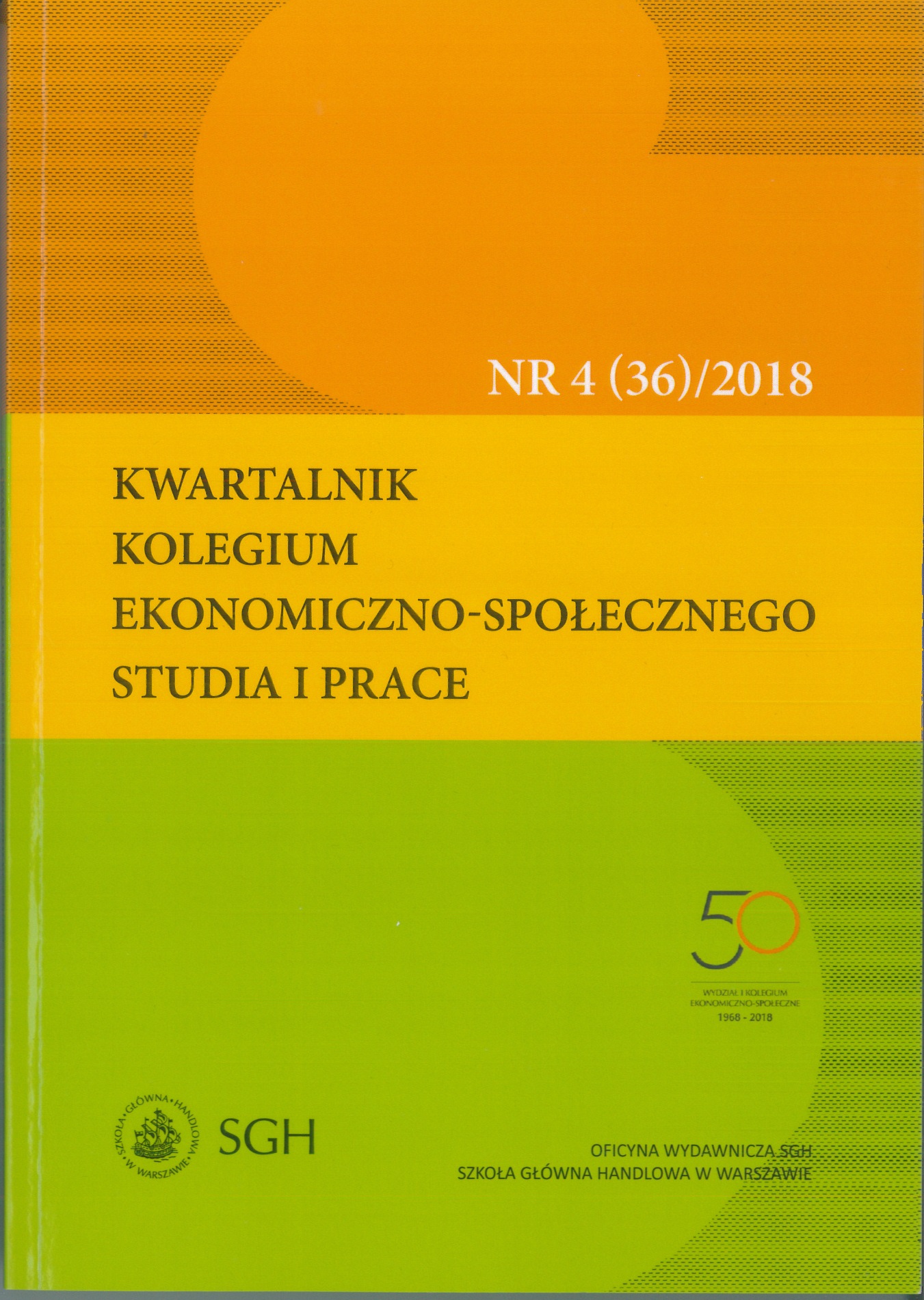Populacja imigrancka w Stanach Zjednoczonych w drugiej dekadzie XXI wieku – próba charakterystyki
Main Article Content
Abstrakt
W artykule, w oparciu o dane źródłowe, dokonano charakterystyki populacji imigranckiej w Stanach Zjednoczonych i zaprezentowano ją na tle populacji obywateli USA z urodzenia. Powstały w ten sposób obraz tego, kim jest współczesny imigrant do USA (uwzględniający takie zmienne, jak region pochodzenia, miejsce obecnego zamieszkania, wykształcenie, zarobki, wiek i dzietność), ma na celu stworzenie tła dla analiz debaty dotyczącej reformy polityki imigracyjnej USA, a także wykorzystywania tematu imigracji, szczególnie nieregularnej, w kampaniach wyborczych.
Downloads
Article Details
Autor (Autorzy) artykułu oświadcza, że przesłane opracowanie nie narusza praw autorskich osób trzecich. Wyraża zgodę na poddanie artykułu procedurze recenzji oraz dokonanie zmian redakcyjnych. Przenosi nieodpłatnie na Oficynę Wydawniczą SGH autorskie prawa majątkowe do utworu na polach eksploatacji wymienionych w art. 50 Ustawy z dnia 4 lutego 1994 r. o prawie autorskim i prawach pokrewnych – pod warunkiem, że praca została zaakceptowana do publikacji i opublikowana.
Oficyna Wydawnicza SGH posiada autorskie prawa majątkowe do wszystkich treści czasopisma. Zamieszczenie tekstu artykuły w repozytorium, na stronie domowej autora lub na innej stronie jest dozwolone o ile nie wiąże się z pozyskiwaniem korzyści majątkowych, a tekst wyposażony będzie w informacje źródłowe (w tym również tytuł, rok, numer i adres internetowy czasopisma).
Osoby zainteresowane komercyjnym wykorzystaniem zawartości czasopisma proszone są o kontakt z Redakcją.
Bibliografia
1. Baker B., Estimates of the Unauthorized Immigrant Population Residing in the United States: January 2014, „Population Estimates” July 2017, U. S. Department of Homeland Security, Office of Immigration Statistics, https://www.dhs.gov/sites/default/ files/publications/Unauthorized%20Immigrant%20Population%20Estimates%20in %20the%20US%20January%202014_1.pdf
2. Centers for Disease Control and Prevention, National Center for Health Statistics, Health Expenditures, http://www.cdc.gov/nchs/fastats/health-expenditures.htm
3. Cohen R. A., Kirzinger W. K., Financial Burden of Medical Care: A Family Perspective, „NHCS Data Brief’’ No. 142, January 2014, dostępny również pod adresem: https:// www.ncbi.nlm.nih.gov/pubmed/24472320
4. Ortman J. M., Guarneri C. E., United States Population Projections: 2000 to 2050, U. S. Census Bureau, Washington, D. C. 2009, dostępny również pod adresem: https:// www.census.gov/content/dam/Census/library/working-papers/2009/demo/us-popproj-2000-2050/analytical-document09.pdf
5. U. S. Census Bureau, Health Insurance Coverage Status and Type by Citizenship Status,Universe: Civilian noninstitutionalized population, 2016 American Community Survey 1-Year Estimate, https://factfinder.census.gov/faces/tableservices/jsf/pages/ productview.xhtml?pid=ACS_13_1YR_B27020&prodType=table
6. U. S. Census Bureau, Nativity and Citizenship Status In the United States, Universe: Total population in the United States 2016 American Community Survey 1-Year Estimates, https://factfinder.census.gov/faces/tableservices/jsf/pages/productview. xhtml?pid=ACS_13_1YR_C05001&prodType=table
7. U. S. Census Bureau, Place of Birth by Year of Entry by Citizenship Status for The Foreign-Born Population, Universe: Foreign-born population 2016, American Community Survey 1-Year Estimates, https://factfinder.census.gov/faces/tableservices/jsf/pages/ productview.xhtml?pid=ACS_13_1YR_B05007&prodType=table
8. U. S. Census Bureau, Selected Characteristics of the Native And Foreign-Born Populations, 2016 American Community Survey 1-Year Estimates, https://factfinder. census.gov/faces/tableservices/jsf/pages/productview.xhtml?pid=ACS_13_1YR_ S0501&prodType=table
9. The World Bank, Current health expenditure (% of GDP), https://data.worldbank. org/indicator/SH.XPD.CHEX.GD.ZS?year_high_desc=true
10. The World Bank, Current health expenditure per capita (current US$), https://data. worldbank.org/indicator/SH.XPD.CHEX.PC.CD?year_high_desc=true
Monografie i opracowania
1. High S., Industrial Sunset: The Making of North America’s Rust Belt, 1969–1984, University of Toronto Press, Toronto 2003.
2. Kennedy J. F., A Nation of Immigrants, Harper Perennial, New York 2008.
3. Lopez S. H., Reorganizing the Rust Belt. An Inside Study of the American Labor Movement, University of California Press, Berkeley, Los Angeles 2004.
4. Norton M. B., Katzman D. M., Escott P. D., Chudacoff H. P., Paterson T. G., Turrle, jr W. M., A People and A Nation. A History of the United States, 4th ed., Houghton Mifflin Company, Boston 1994.
5. Schulman B. J., From Cotton Belt to Sunbelt: Federal Policy, Economic Development, and thetransformation of the South, 1938–1980, Duke University Press, Durham, North Carolina 1994.
6. Sunbelt Rising: The Politics of Space, Place, and Region, red. M. M. Nickerson, D. Dochuk, University of Pennsylvania Press, Philadelphia 2011.
7. Tandy Shermer E., Sunbelt Capitalism: Phoenix and the Transformation of American Politics, University of Pennsylvania Press, Philadelphia 2013.
8. U. S. Immigration Policy, „Independent Task Force Report’’ No. 63, J. Bush, T. F. McLarty III, chairs, E. Alden, project director, Council on Foreign Relations, New York 2009, dostępny również pod adresem: http://i.cfr.org/content/publications/attachments/ Immigration_TFR63.pdf
9. Węgleński J., Imigracja a globalizacja. Przykład Stanów Zjednoczonych, Wydawnictwo Naukowe Scholar, Warszawa 2012.
Artykuły naukowe
1. Choi S., Experiencing Financial Hardship Associated With Medical Bills and Its Effects on Health Care Behavior: A 2-Year Panel Study, „Health Education and Behavior” 8 November 2017, https://doi.org/10.1177/1090198117739671
2. Gibson C., Jung K., Historical Census Statistics on Population Totals By Race, 1790 to 1990, and By Hispanic Origin, 1970 to 1990, For The United States, Regions, Divisions, and States, „Working Paper Series’’ No. 56, Population Division, U. S. Census Bureau, Washington, D. C., September 2002, https://www.census.gov/content/dam/ Census/library/working-papers/2002/demo/POP-twps0056.pdf
3. Grieco E. M., Acosta Y. D., de la Cruz G. P., Gambino C., Gryn T., Larsen L. J., Trevelyan E. N., Walters N. P., The Foreign-Born Population in the United States: 2010, U. S. Census Bureau, Washington, D. C. 2012, dostępne również pod adresem: http:// www.census.gov/prod/2012pubs/acs-19.pdf
4. Grieco E. M., Trevelyan E., Larsen L., Acosta Y. D., Gambino C., de la Cruz P., Gryn T., Walters N., The Size, Place of Birth, and Geographic Distribution of the ForeignBorn Population in the United States: 1960 to 2010 s, „Population Division Working Paper’’ No. 96, U. S. Census Bureau, Washington, D. C., October 2012, s. 24, dostępny również pod adresem: https://www.census.gov/content/dam/Census/library/working-papers/2012/demo/POP-twps0096.pdf
5. Schmidley D., Profile of the Foreign-Born Population in the United States: 2000, U. S. Census Bureau, Washington, D. C. 2001, dostępne również pod adresem: http:// www.census.gov/prod/2002pubs/p23–206.pdf
